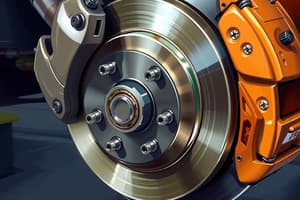Podcast
Questions and Answers
What is one of the main disadvantages of fibreglass as a brake lining material?
What is one of the main disadvantages of fibreglass as a brake lining material?
- It is significantly weaker than aramid fibres.
- It has a low coefficient of friction at low temperatures.
- It is less heat resistant compared to organic linings.
- It has reduced friction at very high temperatures. (correct)
How do the wear resistance and longevity of aramid linings compare to organic materials?
How do the wear resistance and longevity of aramid linings compare to organic materials?
- Aramid linings have worse wear resistance and longevity.
- Aramid linings have significantly lower longevity compared to organic materials.
- Aramid linings have much better wear resistance and longevity. (correct)
- Aramid linings have similar wear resistance but better longevity.
What materials are most ceramic brake pads typically made from?
What materials are most ceramic brake pads typically made from?
- Pure ceramic material only.
- Ceramic material combined with Kevlar.
- Ceramic material mixed solely with aramid fibres.
- Ceramic material mixed with copper fibres. (correct)
Which of the following is true about carbon-metallic pads?
Which of the following is true about carbon-metallic pads?
What is a regulatory requirement for brake pad manufacturers in California and Washington since 2014?
What is a regulatory requirement for brake pad manufacturers in California and Washington since 2014?
What is one characteristic of carbon-ceramic brake pads?
What is one characteristic of carbon-ceramic brake pads?
Which type of brake lining material has a coefficient of friction (COF) similar to semi-metallic linings when cold?
Which type of brake lining material has a coefficient of friction (COF) similar to semi-metallic linings when cold?
What is the typical function of low-copper compliance pads?
What is the typical function of low-copper compliance pads?
In terms of structural strength, how do fibreglass linings compare to organic linings?
In terms of structural strength, how do fibreglass linings compare to organic linings?
Flashcards are hidden until you start studying
Study Notes
Brake Lining Materials
-
Fibreglass: Introduced to replace asbestos; offers good heat resistance, coefficient of friction (COF), and structural strength.
-
Disadvantages include higher cost and lower friction at very high temperatures.
-
Primarily used in rear drum brakes, with performance comparable to organic linings.
-
Aramid Fibres: Synthetic materials that are five times stronger than steel (by weight) and lighter than fibreglass for equal volume.
-
Friction materials made from aramid fibres mimic the structure of organic and fibreglass linings.
-
COF is similar to semi-metallic linings when cold and approaches that of organic linings when hot.
-
Offers performance between organic and semi-metallic materials, excelling in wear resistance and longevity compared to organic options.
Ceramic Brake Linings
- Common on front-wheel drive (FWD) vehicles due to high heat resistance.
- Typically constructed from ceramic material combined with copper fibres, resulting in quiet operation and minimal dust generation.
- Popular for original equipment (OE) and aftermarket replacement due to their beneficial properties.
Carbon-Metallic/Ceramic Pads
- Utilized in high-performance vehicles because of good COF and exceptional heat resistance.
- Capable of enduring very high temperatures without experiencing brake fade.
- Some aftermarket products incorporate carbon, Kevlar, and other materials for enhanced performance.
- Features ceramic heat shields to minimize heat transfer from linings to the brake system.
- Carbon-ceramic pads consist of a ceramic composite reinforced with silicon carbide, providing excellent braking performance and lightweight characteristics.
- Maintain a consistent COF across a wide range of temperatures and conditions.
Low-Copper Compliance Pads
- California and Washington mandated the reduction of copper in brake pads since 2014 to mitigate environmental impact on water sources and aquatic life.
- Three levels of low-copper pads exist:
- Level A: Complies with cadmium, chromium, lead, mercury, and asbestos regulations.
- Level B: Meets Level A standards with copper content reduced to less than 5% by 2021.
- Level N: Requires copper content under 0.5% by 2025.
Studying That Suits You
Use AI to generate personalized quizzes and flashcards to suit your learning preferences.




